In Japan, I woke up a couple of nights angry from dreams about having dinner at the White House, and sitting across from Pres. Obama, and arguing with him about hunger striking prisoners at Guantanamo.
We talked–I talked at him, because, I guess my mind was incapable of imagining a viable retort, really, what could he say?–about Yasiin Bey’s video demonstrating the standard procedure the military uses to force feed hunger strikers through their noses. And I asked if the Constitution was now as quaint as the Geneva Conventions, a reference to Bush era torture theorist John Yoo’s position on following the rule of law and international treaties the US had nominally upheld for decades.
It was the kind of dream where I felt that surge of adrenaline, that this moment, this conversation, was going to be what opened the President’s eyes to the awful urgency of this situation our country is in. These people are in.
I had seen the reports by investigative journalist Jason Leopold which revealed JTF-GTMO’s recent, extraordinary revisions to the prison hospital’s forced feeding procedures. But it wasn’t until a couple of days ago that, with Jason’s assistance, I found the actual military manuals and memos themselves. They are in an archive of documents produced in response to Freedom of Information Act requests maintained byThe Department of Defense’s FOIA Service Center.

I can’t not do something, so I have published the three sets of detainee treatment regulations, known as Standard Operating Procedures, as a book. Which, believe me, I know. I feel a bit like an outraged @Powhida jamming @BarackObama into all his tweets, until the non-effect wore him out.
It’s weird feeling compelled to do something that you recognize is irrational and irrelevant. But again, I can’t not do something, and this is one thing I do. And with all due respect to Richard Prince, this text, as it is, and as it drives the world, is the kind of thing I feel must be propagated and put examined and contextualized if appropriation, or art, or attention, really, is going to mean anything at all.
Standard Operating Procedure includes the SOP Manual for Camp Delta, the prison side of GTMO, which was implemented in 2003. It’s 240-some pages, not including the various classified appendices for detainee transport and adjudication, which have not, apparently, been released. It also contains the 2003 version of SOP for the detention hospital for “Voluntary and Non-Voluntary Total Fasting and Re-Feeding,” which has several p.ages completely redacted. And then there’s the May 2013 revision to those procedures, which are contained in an SOP for the Joint Medical Group for the “Medical Management of Detainees on Hunger Strike.” That’s the regime the detainees are currently under.
Of course, as Leopold and others continue to report, the situation of detainees is even worse than what these SOP prescribe. There are indications that regulations are extensively, if not routinely ignored by guards and prison commanders. These primary documents embody the best case scenario for people who have been cleared for release for years, but who remain in harsh, indefinite, imprisonment.
So whether you buy the book [which should be is finally available to order this weekend, I think; I’ve been experiencing some friction from the printer/publisher, which is kind of annoying, and it’s been going on all week.] or read the regulations in electronic format, read them, and know that they exist.
Buy Standard Operating Procedure, 284pp, unsigned edition, $15.99 +s/h [createspace]
UPDATE: Proof copy – Standard Operating Procedure is here
Category: etc.
Mari X IKEA: autoprogettazione by greg.org (2010)
Three years ago, I was thinking about what to do with the posts I’d written about the project I’d begun six years ago. Which I guess means it’s time to release the results.

So here’s Mari X IKEA, a PDF compilation I made in 2010 aboutfmy 2007-09 project to construct an Enzo Mari autoprogettazione table out of Ikea furniture components.
I was not entirely pleased with the way it read all together, and so I didn’t publish it back in the day. But I realize now that my inner archivist and inner editor will never agree on things, and I/we are becoming OK with it. So the tabloid-style publication contains all the original blog posts and images documenting the project, and that includes a fair amount of recapping and repetition. Meanwhile, my inner publicist wants to emphasize that this is not a bug, but a feature, like the catchy chorus of a song.
I’m still quite stoked about the project–and the table, for that matter, which I am using at this very moment–and it continues to influence and inform my thinking about stuff: art, design, originality, authorship, authority, appropriation, systems, craft, utility. So I’m very happy to get information on the project out there in a more easily consumable format.
I should also give a shoutout to The Newspaper Club, the amazing publishing company, then just starting out, where I had originally contemplated printing Mari X IKEA in 2010. This PDF was made using their easy publishing/layout tool. And though I ended up not pulling the trigger on this particular project, they regularly make me want to turn this blog, and many other things, into a newspaper.
Mari X IKEA: autoprogettazione by greg.org, 2010 [PDF, 2.8mb]
Vintage Duchamp Animated GIF
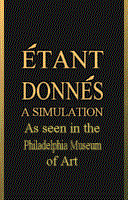
Artist TimK made this animated GIF simulation of viewing Marcel Duchamp’s Étant Donnés some time before January 1998, which was when the Internet Archive crawled his Duchamp webpages for the first time.
That site is long gone, but TimK now has marcelduchamp.org.
Gerrit Rietveld Chair Crate
Not sure how I never considered this, but I suddenly came across a couple of strong connections between Enzo Mari’s autoprogettazione furniture and Gerrit Rietveld.

For one, check out the crate that this 1965 version of Rietveld’s Red Blue chair came in; this one’s from Galerie VIVID in Rotterdam. I’ve never seen this before. Maybe that’s just how they used to make crates in the 60s. But it sure looks like the underside of my Enzo Mari X IKEA table, the EFFE model.

It looks even more like the structure of the Tavolo Quadrato, the square autoprogettazione table.

Then there’s Rietveld’s 1923 Military Table, designed for the Catholic Military Home in Utrecht, and in and out of production ever since. This unfinished Oregon pine example’s from the 60s, and was in Marseille, via 1stdibs. [I have never paid much attention to Rietveld’s Military Table, but suddenly it is looking pretty sweet.

The top is fixed onto these cross braces. It’s a solution that Mari eventually used as well. The crosspieces are not in the original autoprogettazione plans, but they did turn up in the kit of precut parts that were sold under the Metamobile name in the early 70s.
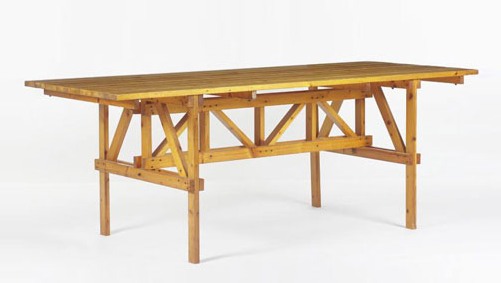
Even though Rietveld’s autonomous approach to furniture is an obvious precedent for Mari’s; and I knew from hands-on experience that the autoprogettazione designs have a lot more “design” than their basic function requires; I guess I never imagined that Mari would make overt references to what had come before.
Previously:
The making of an Enzo Mari dining table
Enzo Mari X IKEA Mashup Recap
The Richard Serra Cookie Incident
When the worst thing to happen last week was still tax day, the folks at Blue Bottle Coffee wrote about rumors circulating in the larger SFMOMA art dessert community about the Richard Serra Cookie Incident. [404 link updated to archive.org, 5/2016]

not-Serra cookie parts image by Charles Villyard
BBC is the outfit responsible for creating the desserts about art at SFMOMA. They have a new book about it. Modern Art Desserts. Available now. It does not include the recipe and assembly diagram, custom-printed on a napkin, for the 2010 cookie-based examination of Richard Serra’s 1969 prop piece, Right Angle Plus One, which is in the Museum’s collection.
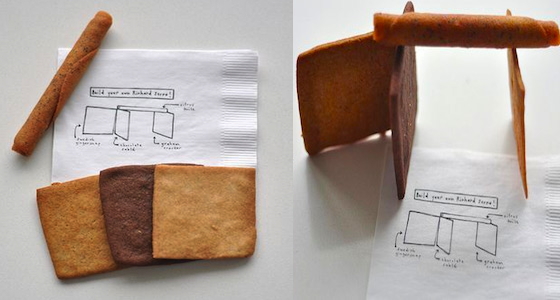
Serra, it turns out, was not amused by the cookie-based critique, as the pastry chefs found out when they met the artist during Gary Garrels’ 2011 drawings retrospective. The best line is also a call to arms:
Going through his retrospective on a routine basis while it was up was such a treat for us. It was also heart-wrenching since EVERYTHING IN THE SHOW LOOKED LIKE A GIANT COOKIE!
Right Angle Plus One is related in time and form to four prop pieces and lead rolls currently on view at Richard Serra’s show at David Zwirner.. It is now impossible to look at that show and not think of recreating it in cookies. Go ahead, just try it!

Setting The Serra Story Straight [bluebottlecoffee via wayne bremser]
Richard Serra Early Works, through June 15, 2013 [davidzwirner]
Chaneling Satelloons
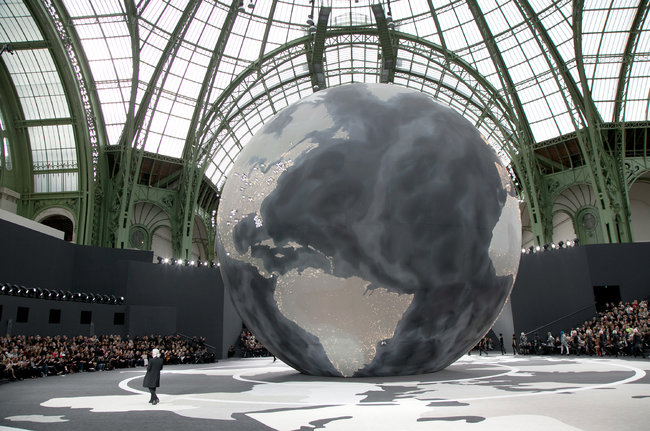
I’d like to announce that my satelloon show “Exhibition Space” will travel from the Grand Palais to New York, where it will open at apexart on March 20th.
I’d like to, but it—eh, you know what, it’s close enough.
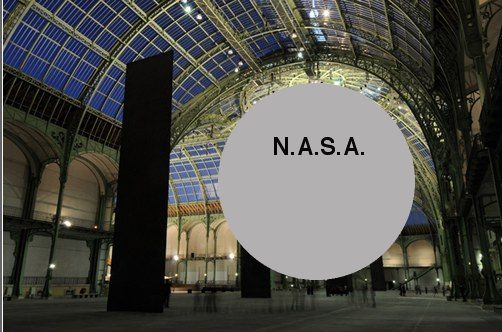
image: Chanel demands a closer look [nyt]
previously, like 2008 previously: Les Sateloons du Grand Palais
RO/LU X J. Crew
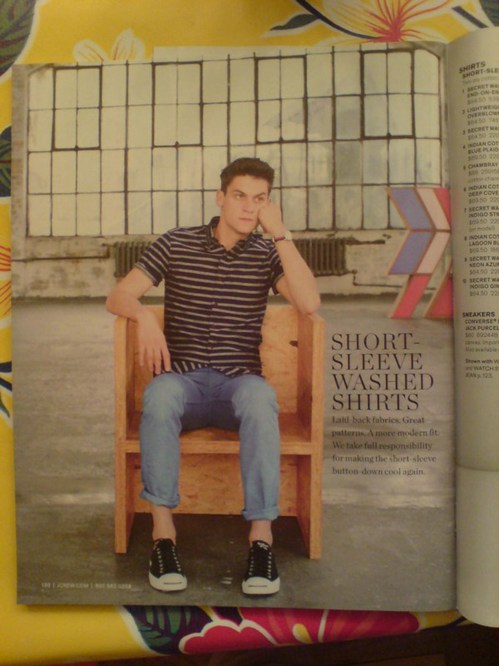
Nice placement, fellas. Looks like J. Crew’s trying to capture a little bit of the RO/LU magic for their own branding goodness.
Untitled (Embroidery Trouble Shooting Guide)

When I first met Richard Serra in 1994 or so, we talked a lot about the Internet. Soon after, I began trying to imagine what a Richard Serra web project would look like. Given the way his sculptures rather definitively reconfigured the space they inhabited, I envisioned a Serra site as a single, massive, interlaced GIF, that rendered in your browser with excruciating, megalithic slowness, controlling time and processing power as well as screenspace.

I mention this now because I think that, after my nearly 20 years online, the Embroidery Trouble Shooting Guide page at sewingandembroiderywarehouse.com comes closest to Serra’s work in terms of its spare, dauntless power.

ETSG is created in Microsoft FrontPage. None of the HTML headings tags are closed, so the text, as Rob at boingboing puts it, grows “inexorably in size until the greatest website in the world is achieved.”

This kind of webby, self-referential recursiveness is similar to, though the inverse of, Moonwalk, Martin Kohout’s standout YouTube video which was a conceptual standout at the Guggenheim’s YouTube Play competition/exhibition a couple of years ago.

ETSG‘s scrolling text is also reminiscent of Serra and Carlotta Fay Schoolman’s 1973 video piece, Television Delivers People.
But of course, it’s all unintentional, even unnoticed. Apparently, the SEW folks say the page renders just fine in Internet Explorer.
Salesman Sample Flags

flag dimensions: 17.75″ x 29.5″, image: Jeff R. Bridgman American Antiques via 1stdibs
Speaking of sweet flags, Andy from reference library sent along this amazing, pre-Johnsian artifact from York, PA antiques dealer Jeff R. Bridgman.
It’s a salesman sample flag, seven parade flags in graduated sizes, sewn together for convenient comparison shopping. The 48-star design and textile quality suggests WWI-era; Bridgman’s description suggests that Jasper Johns must have seen one of these sample sets somewhere before. But then, that’s just what a guy charged with selling it to you would say… In any case, awesome.
48 Star Parade Flag Salesman’s Sample, POR [1stdibs via reference library]
A de C

The first and last time I saw this truck, Donald Judd’s ranch truck, was in the early 1990s, in Marfa. I swear this logo for the ranch, Ayala de Chinati–or am I hallucinating?–used to be painted on the door of 101 Spring St.
Anyway, I’ve been looking for it again all these years because I’ve wanted to knock it off for myself, for my letterhead, if not for the door of my truck, and I couldn’t remember exactly how the letters-in-letters thing went. So I’ll get right on it.
An Artist’s Truck That’s No More Than It Needs To Be [nytimes]
We Go Now To Our Man In Donaueschingen
I’ve been listening to [relatively] a lot of La Monte Young lately, and [slightly less] Tony Conrad–which is harder to work to. And the Cage, of course, because he’s the composer this month in the kids’ school [!]. So it’s all so much that when the radiator kicked in the other day, the kid asked if that was my music.
But is there any other group who’s not so on board with the all-sound-is-music concept than classical orchestra musicians? Perhaps not. Which is a bummer.
Though I doubt a Cageian centennial revolution is the justification for the budget cuts to Southwest German Radio orchestras that have spawned several protests at the Donaueschinger Musiktage new music festival.
Like this amazing protest which New Yorker music guy Alex Ross posted on his blog. Oh, and on YouTube, he is the poster, not just the linker.
A violinist playing a continuous tritone as political protest.
Ich war ein Orchester [therestisnoise]
It’s A Mozingo Thing
My great great grandmother had an awesome name: Mary Argent Mozingo. She was married to the equally well-named Ruffin Sullivan. They were country people, farmers, I suppose, in Wayne County, North Carolina. I knew their daughter, my great grandmother, who lived to be 105, but I never heard her talk of her parents. We found their names when we were in the market for names, and were surfing through family history records. My wife vetoed Mozingo, and my grandmother nixed Ruffin with a swiftness that hinted at family stories that did not get told very often.
While I was still campaigning for Mozingo–just, you know, as a second or third middle name, a fun option, maybe? no?–my mother did say that her grandmother always insisted her mother’s name was Mozzinger. Or Mottsinger, and if it weren’t for some ignorant census clerk somewhere who couldn’t hear or spell right, we wouldn’t even be having this conversation. In any case, it’s not Mozingo.
This was the woman who eventually edited out the stories of working in a cigar factory in Richmond as a young girl, where she won five dollars once for the quickest rolling. And who destroyed oral history tape recordings of her family’s history because of, well, I guess we can only speculate now, since those stories have been lost.
And there’s no chance that a lone census taker messed up, Ellis Island-style, on the Mozingo. If anything, my ancestors’ insecurity about Mozingo is one of the prime indicators of their true Mozingoness.
As LA Times writer Joe Mozingo found out, when he went searching for the origins of his name, which he’d always heard was Italian. Other Mozingos heard it was Portuguese, or Basque. Obviously, to almost everyone not named Mozingo, that is, Mozingo is an African name, brought to early colonial Virginia by one Edward Mozingo:
Edward had been a servant to Col. John Walker, a member of the colony’s legislature. When Walker died in 1669, his widow inherited Edward and remarried a powerful Virginian, John Stone.
Edward sued Stone for his freedom. Little is said about the lawsuit in the court record, only that there was an appeals hearing in the high colonial court, that “Divers Witnesses” testified and that the judges concluded “Edward Mozingo a Negro man” had served his term after 28 years of indenture.
Joe Mozingo’s three-part story of uncovering the Mozingo truth overflows with examples of hardship, racism, insecurity and denial that runs so natural and deep Americans have been soaking in it for centuries.
And that’s just the white Mozingos. People whose identity and racial worldview don’t have room for the complexities of rural intermarriage in 18th century America. For the Black Mozingos, meanwhile, the countervailing impact of generations of discrimination, opportunity, passing, and self-loathing still play out in a Goldsboro, NC barbecue restaurant–which turns out to be the same place we’ve stopped for lunch every summer on the way to the Outer Banks.
The ways family functions as a machine for transmitting memory are one subject of my set of 12 short films, The Souvenir Series; I think I have to add the way family desperately tries to keep things silent for centuries to the mix, too.
In Search Of The Meaning Of ‘Mozingo’, part 1, part 2, and part 3 [latimes via my cousin cara]
John Cage’s Europeras 1 & 2, On Stage Now At The Ruhr Triennial
I’m done waiting. This Europera 1 & 2 post is apparently not going to write itself.

The Ruhr Triennial opened last weekend with what is only the third [production and fourth -ed.] staging of John Cage’s grandest* composition, the 1987 Europeras 1 & 2. It’s basically a chance operations tour de force that runs the entirety of the European opera canon–arias, stories, costumes, props, sets, lighting, libretti, staging, orchestra–through the I Ching wringer, which performance is conducted, so to speak, by the cues of a 2.75-hour clock. As Cage put it, “For 200 years the Europeans have sent us their operas. Now I’m returning all of them.”
All six performances in the Triennial’s home venue, the vast, repurposed industrial Centennial Hall Bochum sold out immediately. So far three have happened, directed by the director of the entire Triennial, avant-garde composer Heiner Goebbels.

So I’ve been monitoring the reviews jealously, and with some indignation. The scale and ambition and significance of the work is being respected—the work has only ever been performed in Germany [update below: not true]—but it seems that both critics and directors alike still struggle with the vocabulary and the very concept of Cage’s chance-driven work.
In the only English-language review I’ve found so far, The Financial Times’ Shirley Apthorp describes Europeras’ “extravagant evening of associative nonsense” as both “chaos” and “minutely choreographed absurdity.” Writing for FAZ Eleonore Buening criticized Goebbels for putting the “chaos Cage conceived a quarter century ago back in a Museumsvitrine.” If I read my German correctly, “The director placed too little confidence,” Buening writes, “in the expiration of the clock, the will of the participants, or even Comrade Chance.” And did Cage ever have a better comrade?
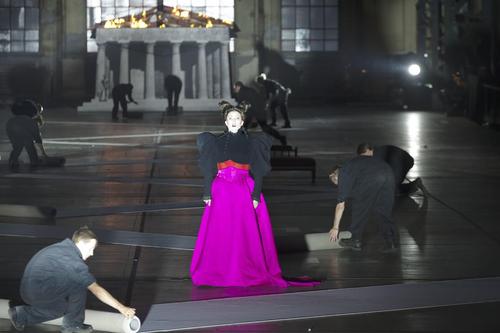
I have never seen Europera 1 & 2, but I’ve been studying up on them for the last year or so. The original staging, commissioned in 1985 by the Frankfurt Opera, was the dissertation subject of Laura Kuhn, who was involved in the production, and who has since become the director of the John Cage Trust.
Europera 1 & 2 strikes me as a simultaneous negation and celebration of opera as an art/theatrical form, but also as a cultural and historical institution. His chance-based composition removes narrative, character arcs, literary and stage conventions, and authorial intentions from the experience of a performance. Chance is not chaos or absurdity; it’s a different syntax. How does any opera performance seem if you don’t know the story or speak the language? Would you ever call it chaos or nonsense?
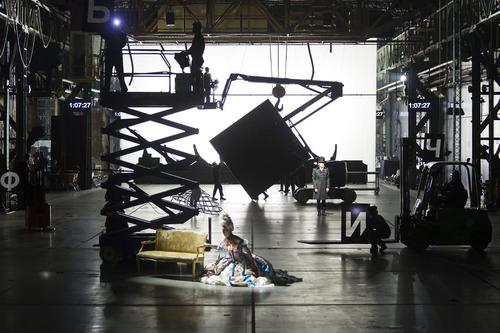
An opera diehard may want to identify the source of every passing prop, aria, or orchestral passage in Europera—did the Stump The Operahead trivia quiz during the intermission of the Met’s weekly radio broadcast ever tackle Cage? Just like a moviehound might try to flag the source of every clip in Christian Marclay’s The Clock. But that risks missing Cage’s point [which is not Marclay’s]: that the experience of the montage has quality and meaning and value in itself, apart from the original content and its juxtapositions, not because of them.
And maybe critics actually are better attuned to this now, and the problem [sic] is just/still the directors. In FAZ, discussing the “Children’s Jury” who Goebbels convened to award unconventional prizes during the Triennial, Buening found a new twist on the classic MTV Crisis when she worried that the media-saturated, “Multi-tasken” Kids These Days might be bored by Cage’s 1980s jump cut revolution. After watching a rehearsal of Europera Ruhr Nachtrichten writer Julia Gass said Cage foreshadowed the “TV Zapp Era”; actually, he was soaking in it. Cage’s vision of the future was surfing the 400 operatic channels of the past.

Europera may be Cage’s most ambitious and explicit appropriationist work. According to Kuhn’s firsthand account of the making of, Cage, relying on the collection of Lincoln Center’s library, determined to include only operas that were in the public domain. For the flats and sets, he had researchers in Germany compile engravings and illustrations of composers, architecture, and animals from pre-20th century books. With these copyright-free source sets established, Cage used chance operations and a time log to generate the content of the opera.
And this, apparently, is where Goebbels’ otherwise extraordinary production falls short. I’ll try to account for the differences—or more precisely, the changes—between Goebbels’ version and Cage’s, the immediately apparent one is his replacement of simple, graphic flats with actual operatic sets. Buening sees this as too deterministic, too willfully absurdist [in the mold of Robert Wilson, who, inexplicably, is the Triennial’s English talking head for Europera], and stuck to the cliches and one-liners of operatic theatricality. And too much of the director’s own indulgences, which runs diametrically counter to Cage’s purging intentions.
It’s a perennial problem with Cage’s interpreters, who take the indeterminacy of his compositions as license to do whatever they want. Not coincidentally, that sounds like exactly the criticism voiced in OMM by Sebastian Hanusa over the previous production of Europeras 1 & 2 at the Hannover State Opera. [It opened in October 2001, and I confess, I was not paying much attention to German opera gossip at the time.] According to Hanusa, Lowery kept the aria singers offstage, and instead of the chance-derived staging, he created various storytelling set pieces. It sounds almost as bad as Cage’s sabotaged NY Phil debut in 1964.
But it’s better than nothing? I don’t know. Is it the kind of thing you can watch on DVD? Will Europeras ever be staged in the US? [YES, SEE BELOW.] Frankly, we may still not be ready for it. Or maybe we’ve superseded it; with the right code and a few browser tabs on YouTube, we can generate our own Europera anytime we want. Man Bartlett’s #12hPoint, I’m looking at you.
UPDATE/CORRECTION: Thanks to DJW for correcting me; Europeras 1 & 2 was staged in the US. Christopher Hunt brought the original Frankfurt production to Summerfare at SUNY Purchase in 1988. According to John Rockwell’s bemused NY Times’ review, the New York version, which took place on a grander stage, was actually closer to Cage’s original vision, which the Frankfurt Opera had to rework after its main theater was damaged by arson just before the Europeras‘ premiere. Anyway, more to come on that.
* OK, the 639-year-long organ performance of As Slow As Possible, also from 1987, at St. Burchardi church in Halberstadt is also pretty grand. But I’d argue its grandeur is more the performance, not necessarily the composition.
Thoughts On The Future Of Beef Husbandry In Grass Valley, Utah
American grain-fed beef will still remain the number one choice of Americans who dine out. Health food fanatics with bogus credentials will continue to slam producers and consumers of beef for destroying the environment and the health of children who are supposedly being poisoned by red meat when organic vegetables, tofu and soy milk are their answers to the world’s health problems. More and more pressure in the form of increased year around recreation demand by citizens cloistered much of the year in their Wasatch Front and Southern California neighborhoods will test the patience of ranchers and farmers in the valley who find their gates left open, livestock scattered, sprinkler pipes shot full of holes, crops trampled by four-wheelers and fences cut so hunters can get closer to that “real good hunting spot.”
…
One thing that won’t change is that there will always be some young men or women who are willing to sacrifice guaranteed vacations, retirement programs, forty-hour weeks and twelve holidays a year with pay, just for the challenge and satisfaction of being a rancher/farmer. The drive or motivation to be a provider of food and fiber for a nation is still alive in a few young people in Grass Valley. May that hunger to work with the soil and the beasts never be lost or destroyed.
excerpted from Verl Bagley’s extensively researched history and future of “Beef Husbandry in Grass Valley,” p. 222 of the impressive if not quite comprehensive Grass Valley History, Including the Communities of Box Creek, Burrville, Greenwich, Koosharem, published privately in 2005, which I saw a heavily used, duct-taped copy of near the register at the Koosharem Cafe the other day. And when I inquired about it, the lady helping me called down to the store to see if they had a copy. And then she called over to Carol’s place, and sure enough, Carol had a copy I could buy, did I know Carol? And that’s when I had to confess that until she said it on the phone just then, I was unsure how to pronounce Koo-SHARE-em, we were just on a quick, first family history visit. But Carol was right down the road, and sure enough, she answered the door with a copy, and was surprised to take money, didn’t I pay down to the store?
In any case, an unexpected and invaluable resource for my research into the contentious history of irrigation in and around Burrville.
Hot Mountain

So I’m walking to the lodge at Snowbird the other day, and they’re sealing cracks in the parking lot with tar on the ends of these long stick/wand things, and suddenly it’s all palimpsests and Brice Marden all over the place.
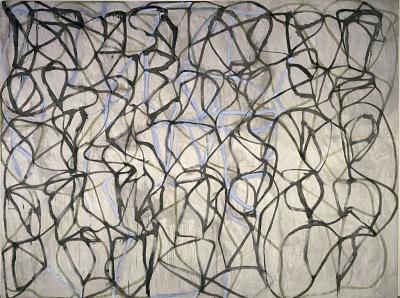
Cold Mountain 2, hirshhorn.si.edu
